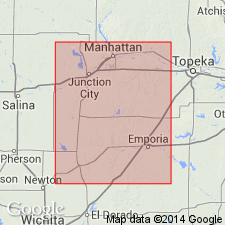
- Usage in publication:
-
- Florence limestone
- Modifications:
-
- Original reference
- Dominant lithology:
-
- Limestone
- AAPG geologic province:
-
- Sedgwick basin
Summary:
Pg. 771-786, 798. Florence limestone (or Fort Riley limestone). Massive buff limestone, 5 or more feet thick. Separated from overlying Marion flint by 22 feet of buff shaly limestones overlain by 62 feet of varicolored shale with thin limestone layers, and separated from underlying Florence flint by 15 feet of buff shaly limestones.
Named from Florence, Marion Co., KS.
Source: US geologic names lexicon (USGS Bull. 896, p. 744); GNC KS-NE Permian Corr. Chart, Oct. 1936).

- Usage in publication:
-
- Florence limestone†
- Florence flint
- Modifications:
-
- Overview
Summary:
In 1902 (Jour. Geol., v. 10) Prosser redefined Fort Riley limestone, to include at base the 15 feet of shaly limestones and at top the 22 feet of buff shaly limestones, both of which he had excluded in his original definition. He also stated that Fort Riley limestone (40 feet thick) rested on Florence flint and was separated from overlying Marion flint by Doyle shale; that Florence limestone is Fort Riley main ledge; and that Florence limestone is abandoned.
In succeeding years Prosser's 1902 definition of Fort Riley limestone was adopted generally, Florence limestone fell into disuse, and Florence flint was name applied to the formation underlying Fort Riley limestone. In 1936 (Kansas Geol. Soc. 10th Ann. Field Conf. Gdbk., p. 12) R.C. Moore revised the terminology of the Permian rocks of Kansas by (1) restricting Fort Riley limestone to the original 5-foot massive ledge; (2) introducing Oketo shale for underlying 5 feet of shaly limestone; (3) applying Florence limestone to underlying 30 feet of beds bearing the symbol of flinty limestone and apparently corresponding to Florence flint of previous reports. He called the beds immediately overlying his Fort Riley limestone the Holmesville shale, and the beds immediately underlying his Florence limestone, the Blue Springs shale.
Source: US geologic names lexicon (USGS Bull. 896, p. 744).
For more information, please contact Nancy Stamm, Geologic Names Committee Secretary.
Asterisk (*) indicates published by U.S. Geological Survey authors.
"No current usage" (†) implies that a name has been abandoned or has fallen into disuse. Former usage and, if known, replacement name given in parentheses ( ).
Slash (/) indicates name conflicts with nomenclatural guidelines (CSN, 1933; ACSN, 1961, 1970; NACSN, 1983, 2005, 2021). May be explained within brackets ([ ]).

